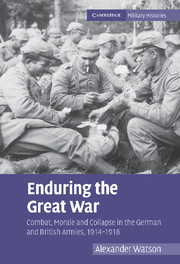Book contents
- Frontmatter
- Contents
- List of plates
- List of figures
- List of tables
- Acknowledgements
- List of abbreviations
- Map: The Western Front 1914–1918
- Introduction
- 1 War of endurance
- 2 Why men fought: combat motivation in the trenches
- 3 Self-deception and survival: mental coping strategies
- 4 Junior leadership: command, cohesion and combat motivation
- 5 Morale and military endurance
- 6 The German collapse in 1918: strike, mutiny or an ordered surrender?
- Conclusion
- Appendix 1 Walter Ludwig's study of Württemberg soldiers' coping strategies
- Appendix 2 Psychiatric casualties in the German and British armies
- Appendix 3 Military ranks and status in the German and British armies
- Glossary of German terms
- Bibliography
- Index
Appendix 3 - Military ranks and status in the German and British armies
Published online by Cambridge University Press: 05 February 2014
- Frontmatter
- Contents
- List of plates
- List of figures
- List of tables
- Acknowledgements
- List of abbreviations
- Map: The Western Front 1914–1918
- Introduction
- 1 War of endurance
- 2 Why men fought: combat motivation in the trenches
- 3 Self-deception and survival: mental coping strategies
- 4 Junior leadership: command, cohesion and combat motivation
- 5 Morale and military endurance
- 6 The German collapse in 1918: strike, mutiny or an ordered surrender?
- Conclusion
- Appendix 1 Walter Ludwig's study of Württemberg soldiers' coping strategies
- Appendix 2 Psychiatric casualties in the German and British armies
- Appendix 3 Military ranks and status in the German and British armies
- Glossary of German terms
- Bibliography
- Index
Summary
German soldiers were distinguished not only by rank but also according to their place in their army's mustering organisation. In peacetime, conscripts underwent two years of training (three in the cavalry and horse artillery) in Aktive units after which they passed into the reserve where they were categorised by age: Reservist (aged 23–7), Landwehrmann (Class I aged 28–32 and Class II aged 33–8) and Landsturmmann (Class II aged 39–45; Class I comprised men of 17–39 who had not yet served). Men under 33 who were not trained before 1914 but recruited during the war were known as Ersatzreservisten. Kriegsfreiwillige were wartime volunteers and Einjährig-Freiwillige were soldiers with the educational and social qualifications necessary to be commissioned as reserve officers and who, before the war, undertook one year of military training which they paid for themselves. Officers were divided into active, Reserve and Landwehr. Those who had retired were categorised as außer Dienst (out of service) or zur Disposition (at disposal). Members of both groups rejoined the army at the outbreak of war.
British troops were additionally categorised according to the type of service for which they had contracted. Regular soldiers were pre-war professionals. NCOs could serve for up to twenty-one years, but most of the rank and file spent seven years in the army, before being transferred to the ‘Regular Reserve’ for five years and, in some cases, the ‘National Reserve’ thereafter.
- Type
- Chapter
- Information
- Enduring the Great WarCombat, Morale and Collapse in the German and British Armies, 1914–1918, pp. 241 - 243Publisher: Cambridge University PressPrint publication year: 2008



